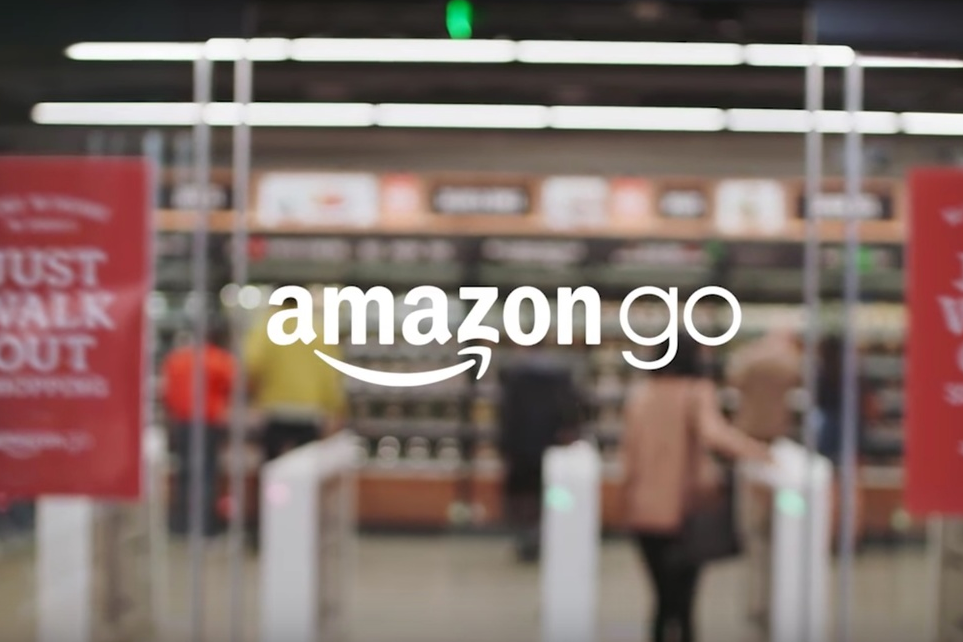
Poised to disrupt the retail industry further, Amazon launches a new retail store model in downtown Seattle where customers can purchase groceries by grabbing food off the shelf and walking out without ever having to wait in checkout lines. Customers simply scan their mobile phone on a turnstile when they enter, activating their Amazon Prime account and logging into the store’s produce-tracking network.
The concept is called Amazon Go and uses machine-learning, sensors, and AI to track items removed from the shelf and placed into shopping bags. The value of items is totaled in a virtual shopping cart that automatically charges the lump sum to customer’s Amazon account upon exiting the store. Change your mind about an item and placing it back on the shelf debits its value from the shopping ledger.
Currently in beta stage, the first Amazon Go retailer is exclusive to company employees but will go public in 2017. All anyone needs to participate in the program is an Amazon account, a supported smartphone, the Amazon Go app, and proximity to an Amazon Go facility. Once registered, users can purchase what the company claims is a variety of ready-to-eat meals and snack options, along with a “selection of grocery essentials ranging from staples like bread and milk to artisan cheeses and locally made chocolates. You’ll find well-known brands we love, plus special finds we’re excited to introduce to customers.”
Check out Amazon’s official video below:
After years of investigating the grocery business, the eCommerce giant finally moves into the brick-and-mortar space, following the example of its newly opened physical bookstore, Amazon Books. Amazon said it began investigating the concept four years ago but wanted to “push the boundaries of computer vision and machine learning,” as well as data pulled from a tangle of sensors — a combination of technology that sounds a lot like what enables self-driving cars.
Knowing this, using the verbiage “machine-learning” in conjunction with “computer vision” implies the presence of a camera system that tracks not just items removed from the shelf but customer’s movement throughout the store.
Amazon hasn’t revealed any specific technology, but an excerpt from a patent filed in the early part of 2015 describes a new kind of grocery store that uses cameras, sensors, and RFID readers to identify shoppers along with the items they’ve chosen.
“When the customer passes through the exit (transition area) of the retail location, the items picked by the user may be automatically transitioned from the material's handling facility to the user, and the user may be charged a fee for the items. … For example, if the user is purchasing items from a retail location, rather than the user having to stop and ‘check out’ with a cashier, teller, or automated check station, because the picked items are already known and identified on an item identifier list associated with the user, the user may simply exit the retail location with the items. The exit of the user will be detected and, as the user passes through the exit (transition area), the user, without having to stop or otherwise be delayed, will automatically be charged a fee for the items (the items are transitioned to the user).”
Cutting shopping queues out your life is convenient, but convenience often comes with a price. Job loss is an inevitable and obvious outcome. What’s less obvious is Amazon’s ability to precisely measure how long you linger in front of specific products that you don’t end up buying and using that knowledge to subtly influence future targeted marketing strategy or selling that information to other advertisers.
Amazon Go may potentially disrupt the market at the same level that e-commerce disrupted brick-and-mortar retailers. Business Insider reports that Amazon plans to open 2,000 brick-and-mortar grocery stores over the next decade, beginning with 20 stores by the end of 2018 in cities such as Las Vegas, Miami, New York, and Seattle. Internal documents leaked earlier this year corroborate this, suggesting that CEO Jeff Bezos is looking to take a more aggressive stance against entrenched grocery companies and reshape the industry.
What we can safely say is that a brick-and-mortar store is a logical partner for Amazon’s massive distribution network. From drone delivery to the cloud to server provider, Amazon doesn’t shy away from experimenting with new forms of enterprise. When such a behemoth speaks, we’re wise to listen.
Source: Amazon
Advertisement
Learn more about Electronic Products Magazine





